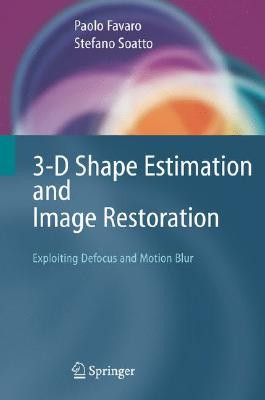| 3-D Shape Estimation and Image Restoration: Exploiting Defocus and Motion-Blur 2007 Edition Contributor(s): Favaro, Paolo (Author), Soatto, Stefano (Author) |
|
 |
ISBN: 1846281768 ISBN-13: 9781846281761 Publisher: Springer OUR PRICE: $66.45 Product Type: Hardcover - Other Formats Published: December 2006 Annotation: Images contain information about the spatial properties of the scene they depict. When coupled with suitable assumptions, images can be used to infer three-dimensional information. This useful volume concentrates on motion blur and defocus, which can be exploited to infer the 3-D structure of a scene???as well as its radiance properties???and which in turn can be used to generate novel images with better quality. 3-D Shape Estimation and Image Restoration presents a coherent framework for the analysis and design of algorithms to estimate 3-D shape from defocused and motion blurred images, and to eliminate defocus and motion blur to yield "restored" images. It provides a collection of algorithms that are optimal with respect to the chosen model and estimation criterion. Topics and Features include: ??? Comprehensive introduction to guide readers through the different areas of the topic ??? Basic models of image formation ??? Discussion of least-squares shape from defocus ??? Unifying defocus and motion blur ??? Handling multiple moving objects ??? Dealing with occlusions ??? Appendices supply the necessary background in optimization and regularization ??? www.eps.hw.ac.uk/~pf21/FavaroSoattoBook/downloads contains implementations of relevant algorithms, test data and demos. Written for readers with interests in image processing and computer vision and with backgrounds in engineering, science or mathematics, this highly practical text/reference is accessible to advanced students or those with a degree that includes basic linear algebra and calculus courses. It can also be seen as a resource for practitioners looking to expand their knowledgein the subject. |
| Additional Information |
| BISAC Categories: - Computers | Computer Graphics - Computers | Computer Vision & Pattern Recognition - Computers | Image Processing |
| Dewey: 621.367 |
| LCCN: 2006931781 |
| Physical Information: 0.61" H x 6.48" W x 9.28" (1.25 lbs) 264 pages |
| Descriptions, Reviews, Etc. |
| Publisher Description: Images contain information about the spatial properties of the scene they depict. When coupled with suitable assumptions, images can be used to infer thr- dimensional information. For instance, if the scene contains objects made with homogeneous material, such as marble, variations in image intensity can be - sociated with variations in shape, and hence the "shading" in the image can be exploited to infer the "shape" of the scene (shape from shading). Similarly, if the scene contains (statistically) regular structures, variations in image intensity can be used to infer shape (shape from textures). Shading, texture, cast shadows, - cluding boundaries are all "cues" that can be exploited to infer spatial properties of the scene from a single image, when the underlying assumptions are sat- ?ed. In addition, one can obtain spatial cues from multiple images of the same scene taken with changing conditions. For instance, changes in the image due to a moving light source are used in "photometric stereo," changes in the image due to changes in the position of the cameras are used in "stereo," "structure from motion," and "motion blur. " Finally, changes in the image due to changes in the geometry of the camera are used in "shape from defocus. " In this book, we will concentrate on the latter two approaches, motion blur and defocus, which are referred to collectively as "accommodation cues. |